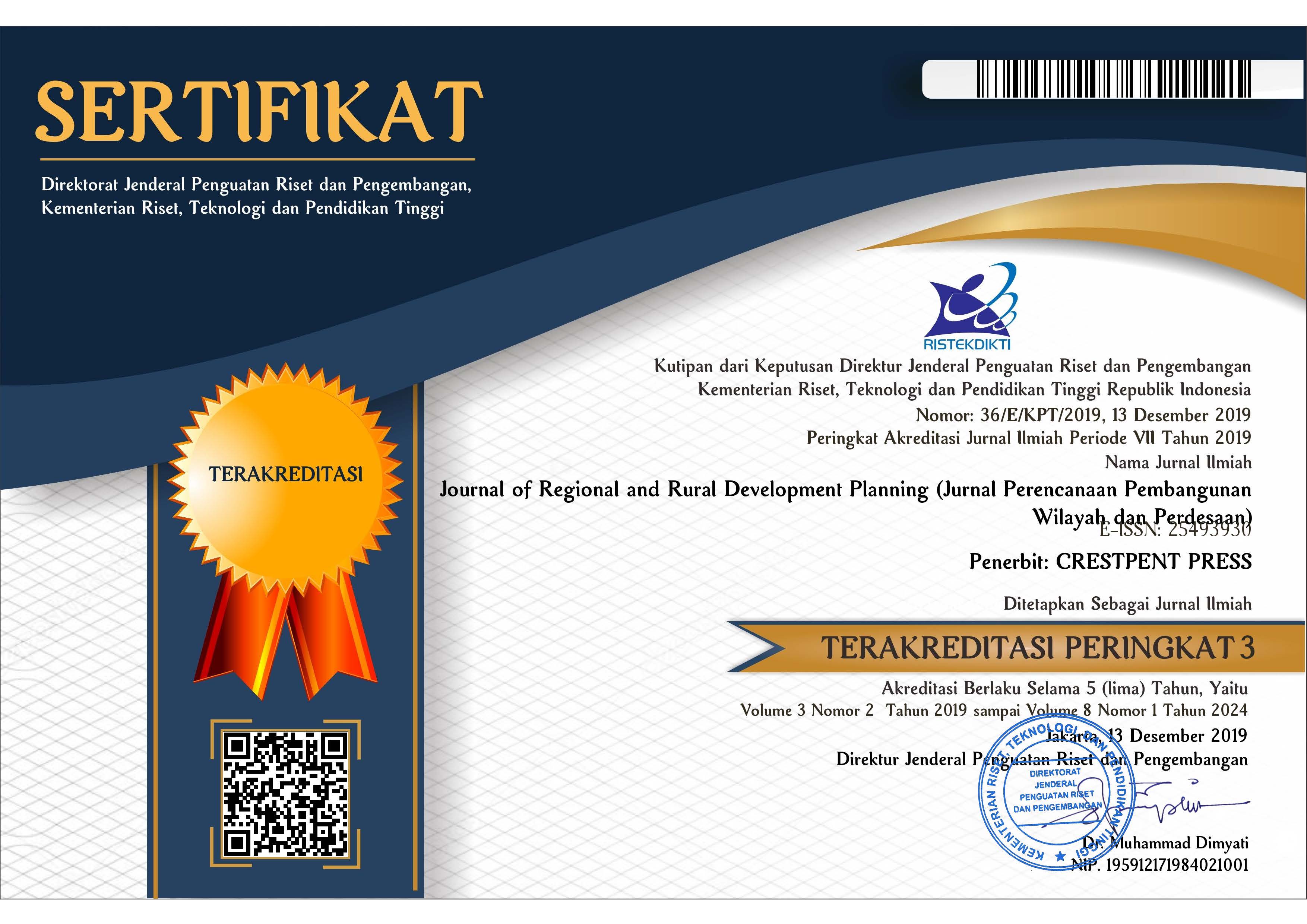Strategi Peningkatan Kualitas Lingkungan Kampung-Kota dalam Rangka Pembangunan Kota yang Inklusif dan Berkelanjutan: Pembelajaran dari Kasus Kota Bandung
Abstract
Among the Sustainable Development Goals (SDGs), there is a goal to create cities and settlements that are safe, resilient, inclusive, and sustainable. In the context of inclusive and sustainable development, all citizens have rights on the city, especially in the context of housing as one of the primary needs that have to be addressed and prioritized by government. All of urban residents, including low-income and urban dwellers, have equal rights to live a decent life, for affordable housing, for healthy residential environment and for equal distribution of public services and basic infrastructure. In this context, the existence of urban kampongs, which dominate urban-housing areas and provide residential area for many low-income communities, needs attention in urban development. The purpose of this study is to formulate generic strategies towards urban kampong quality improvement, both socially and environmentally. Using mix-method (spatial analysis, content analysis, dan SWOT analysis) this paper explains the distribution and characteristics of urban kampongs in Bandung city and formulate strategies to improve the quality of urban kampong environments towards inclusive and sustainable development. This study shows that more than 55% of urban kampong in Bandung belong to the category of slums area. The results of this study concluded that the sustainability status on the socio-economic dimension is still relatively higher compared to physical dimension. This study also formulated strategies both from physical and socio-economic aspects based on case studies in three urban kampong areas in the city of Bandung.
References
[BPS]. (2005). Proyeksi Penduduk Indonesia (Indonesian Population Projection) 2000-2025. BPS, Bappenas, UNFPA.
Caves, R. W. (2005). Encyclopedia of the City. Routledge.
Creswell, J. W. (2014). Research Design: Pendekatan Kualitatif, Kuantitatif, dan Campuran (Edisi 4). Pustaka pelajar.
Dee Roo, G. & Porter, G. (2007). Fuzzy Planning: The Role Actors In A Fuzzy Governance Environment. Ashgate Publishing.
Ewing, R. & Cervero, R. (2010). Travel and the Built Environment: A Synthesis. Journal of the American Planning Association.
Ilma, F. & Rakhmatulloh, A. S. (2014). Pembentukan Struktur Ruang Kompak di Kawasan Banyumanik Kota Semarang. Jurnal Pembangunan Wilayah dan Kota, 10 (2), 139-152.
Jabareen, Y R. (2006). Sustainable Urban Forms: Their Typologies, Models, and Concepts, SAGE Journals, 26 (1).
Jenks, M. & Burgess, R. (2000). Compact Cities: Sustainable Urban Forms for Developing Countries. Taylor & Francis.
Kustiwan, I. (2014). Keberlanjutan Kampung Kota Dalam Strategi Regenerasi Perkotaan Studi Kasus: Kawasan Pusat Kota Bandung. Bandung: Laporan Akhir Penelitian (Riset) Inovasi ITB, Program Studi Perencanaan dekWilayah dan Kota, SAPPK-ITB.
Leitmann, J. (1999). Sustaining Cities: Environmental Planning and Management in Urban Design. McGraw Hill.
Maftuhin, A. (2017). Mendefinisikan Kota inklusif: Asal-Usul, Teori dan Indikator. Tata Loka, 19 (2), 93-103.
Miquel, S. B., Blanes, J. P., & Frediani, A. (2016). Institutionalization And Depoliticization Of The Right To The City: Changing Scenarios For Radical Social Movements. International Journal Of Urban And Regional Research (IJURR), 40 (2), 321-339.
Neuman, M. (2005). The Compact City Fallacy. University of New South Wales.
Nugroho, A. C. (2009). Kampung Kota Sebagai Sebuah Titik Tolak Dalam Membentuk Urbanitas Dan Ruang Kota Berkelanjutan. Jurnal Rekayasa, 13 (3), 209-2018.
Reeves, D. (2005). Planning for Diversity: Policy and Planning for a World of Difference. Routledge.
Roychansyah, M. S. (2008). Pembangunan Berorientasi Kampung: Inovasi Percepatan Pembangunan Perumahan di Perkotaan. Seminar Nasional Perumahan: Strategi Percepatan Pembangunan Nasional, 190-205. Jakarta: Universitas Bina Nusantara.
Roychansyah, M. S. (2009). Towards Kampung Oriented Development: Measuring Sustainabillity Performance of Kampung Using CASBEE Application. 10th SENVAAR (International Seminar on Environment & Architecture), B-VI-3-1 – B-VI-3-13. Manado: Universitas Sam Ratulangi.
Setiawan, B. & Haryadi. (2002). Penyusunan Indikator-indikator Keberlanjutan Kota di Indonesia. Jurnal Manusia dan Lingkungan. 9 (3), 115-125.
Setiawan, B. (2010). Naskah Pidato Pengukuhan Jabatan Guru Besar Dalam Ilmu Perencanaan Kota Universitas Gadjah Mada “Kampung Kota dan Kota Kampung: Tantangan Perencanaan Kota di Indonesia”. Universitas Gadjah Mada.
Sudarwanto, B., Pandelaki, E. E., & Soetomo, S. (2014). Pencapaian Perumahan Berkelanjutan: Pemilihan Indikator Dalam Penyusunan Kerangka Kerja Berkelanjutan. Jurnal Pembangunan Wilayah dan Kota, 14 (2), 105-112.
Tunas, D. & Peresthu, A. (2010). The self-help housing in Indonesia: The only option for the poor?. Jurnal Of Habitat International, 34 (2), 315-322.
Turner, J. F. C. (1976). Housing By People: Towards Autonomy In Building Environment. Marion Boyars.
United Nation. (2016). Habitat III – New Urban Agenda. Habitat III Secretariat United Nation (UN).
Wheeler, S. M. (2000). Planning for Metropolitan Sustainability. SAGE Journals, 20 (2).
Wheeler, S. M. (2004). Planning for Sustainability: Creating Livable, Equitable, and Ecological Communities. Routledge.
Widjaja, P. (2014). Kampung-Kota Bandung. Graha Ilmu
Copyright (c) 2019 Journal of Regional and Rural Development Planning

This work is licensed under a Creative Commons Attribution-ShareAlike 4.0 International License.




.png)














